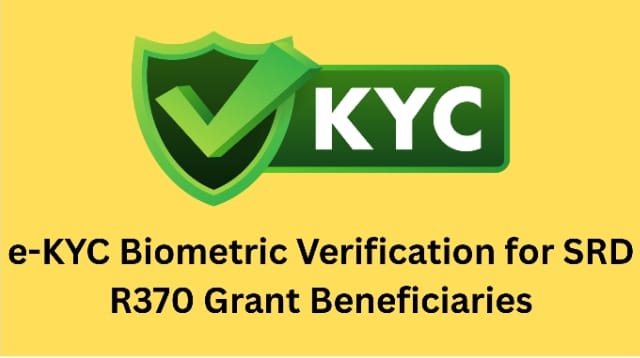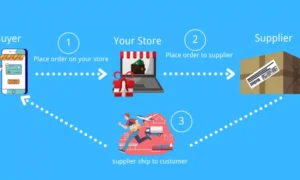The South African Social Security Agency (SASSA) has started using advanced biometric technology for e-KYC (electronic Know Your Customer) verification of SRD R370 grant beneficiaries. This step is to improve security, reduce fraud, and ensure that only the right people receive the grant. Many beneficiaries regularly search for updates through the SRD SASSA status check, and this new verification system will now play a central role in confirming identities before payments are made.
This article explains how biometric e-KYC works, why SASSA has introduced it, and how it will impact grant recipients. We will also share information about SRD grant payment dates for 2025 and the website where updates are posted.
What is e-KYC Biometric Verification?
e-KYC biometric verification is a digital process used to confirm the identity of a person using unique physical features. Instead of depending on manual checks or paper documents, this system uses biometric data such as fingerprints, facial recognition, or iris scans.
SASSA has introduced this technology for SRD R370 grants to make the identity confirmation process more secure. Traditional verification systems were open to fraud, where people could use false documents or apply more than once. With biometrics, each person is linked to one identity only, removing the chance of duplicate or fake applications.
Why SASSA Introduced Biometric Verification
SASSA manages millions of grant applications every year, and fraud has always been a serious challenge. Some people used to apply using stolen or fake identities. Others created multiple profiles to get more than one payment.
To solve this, SASSA adopted e-KYC biometric verification. The reasons include:
- Improved Security – Biometrics prevent identity theft. No two people have the same fingerprint or facial pattern.
- Faster Verification – Digital systems speed up the process of confirming identities.
- Reduced Fraud – Duplicate applications and false claims can be blocked.
- Accurate Records – Each beneficiary is linked to a single identity, which improves database accuracy.
- Future Readiness – The system can be expanded to support other SASSA grants in the future.
By using the latest technology, SASSA shows its commitment to transparency and fairness.
How the Biometric Verification Process Works
The new biometric system follows a simple step-by-step process:
- Enrollment – Beneficiaries register their biometric details, such as fingerprints or facial scans, during application or re-verification.
- Storage – The system saves this data securely in encrypted databases.
- Verification – Each time a person checks their grant status or collects payment, the system matches their biometrics against the stored records.
- Approval – If the biometric data matches, the system confirms the beneficiary’s identity, and payment continues.
- Rejection of Fraud – If the data does not match, the system blocks the attempt to prevent fraud.
The process is quick, accurate, and reliable. Beneficiaries no longer need to worry about carrying multiple documents each time.
Impact on SRD R370 Grant Beneficiaries
The shift to e-KYC biometric verification has both benefits and responsibilities for grant recipients.
Benefits:
- Secure Payments: No one else can claim your grant.
- Faster Processing: The system reduces waiting times for verification.
- Easy Status Check: Online SRD SASSA status check becomes more reliable since it matches biometric data.
- Better Record Keeping: Each beneficiary’s information is safe and unique.
Responsibilities:
- Beneficiaries must complete biometric enrollment.
- If called for re-verification, they should provide their fingerprints or facial scans at the nearest SASSA office or via the mobile app.
- They must keep their personal details updated with SASSA.
How to Do SRD SASSA Status Check After Biometric Enrollment
Once biometric verification is complete, beneficiaries can still check their SRD status online. The process remains simple:
- Visit the official SASSA SRD website.
- Enter your ID number and cellphone number.
- The system will match your identity with biometric records.
- The result will show if your application is approved, pending, or declined.
This process ensures that status checks remain accurate, reducing the risk of errors or mismatched information.
Technology Behind SASSA’s Biometric System
SASSA uses advanced digital solutions supported by secure databases and encrypted communication systems. The biometric system includes:
- Fingerprint Scanners – For high accuracy.
- Facial Recognition Tools – Useful for mobile verification.
- Encrypted Cloud Storage – Protects beneficiary data.
- AI-Based Matching – Ensures quick results.
These technologies are globally recognized and widely used in financial institutions and government services.
SRD Grant Payment Dates for 2025
Grant beneficiaries always look forward to monthly payment dates. For 2025, SASSA continues to release dates in advance, but updates may change from month to month.
The official payment dates for SRD R370 grants in 2025 are being regularly updated on the SRD payment dates website. Beneficiaries should visit this site often to stay informed.
This ensures you do not miss important updates about when payments will reflect in your account.
Advantages of e-KYC for Government
The introduction of e-KYC biometrics also benefits SASSA and the South African government:
- Lower Fraud Losses: Reduced fraudulent claims save money.
- Efficient Systems: Less paperwork and faster verification.
- Better Planning: Accurate beneficiary data helps in budgeting.
- Public Trust: Transparency improves confidence in SASSA.
This technology is not just an upgrade; it is a major shift in how grants are managed.
Challenges Beneficiaries May Face
While the biometric system is effective, some challenges may occur:
- Technical Issues – Poor internet or system errors may delay verification.
- Accessibility – People in rural areas may find it harder to reach biometric enrollment centers.
- Elderly Beneficiaries – Some older people may struggle with fingerprints due to worn-out ridges.
- Awareness – Some beneficiaries may not know they need to re-enroll.
SASSA is working to fix these issues by setting up more help centers, mobile enrollment units, and awareness campaigns.
Step-by-Step Guide for Beneficiaries
To make the process easier, here is a clear guide:
- Register Biometrics: Visit the nearest SASSA office or follow official instructions for mobile enrollment.
- Confirm Identity: Provide ID and cellphone details for linking with biometrics.
- Do Status Check: Use the SRD SASSA status check option online to see updates.
- Follow Payment Dates: Regularly visit SRD for 2025 payment schedules.
- Stay Updated: Check SMS alerts or official notices for any changes.
By following these steps, beneficiaries can avoid problems and ensure smooth payments.
How e-KYC Reduces Fraud in SRD Grants
Fraud in grant systems can happen in many ways:
- Fake applications using stolen IDs.
- Multiple applications under different names.
- Payments claimed by someone other than the beneficiary.
Biometric e-KYC blocks all these tricks because fingerprints and facial scans cannot be copied or shared. Each person is linked to one identity only, which makes fraud almost impossible.
What Beneficiaries Should Do Next
If you are a current SRD R370 grant recipient, make sure to:
- Enroll for biometric verification as soon as possible.
- Use your registered cellphone number for communication with SASSA.
- Visit the payment date website to track payment dates for 2025.
- Always use official channels for SRD SASSA status check.
Staying active in the process ensures that your payments are never delayed or stopped.
Final Thoughts
The shift to e-KYC biometric verification marks a new era for SASSA and its grant beneficiaries. By utilizing advanced technology, the agency has taken significant steps to enhance security, mitigate fraud, and expedite the verification process.
For SRD R370 beneficiaries, the system offers both security and convenience. Payments will be safer, and online SRD SASSA status check results will be more reliable.


































